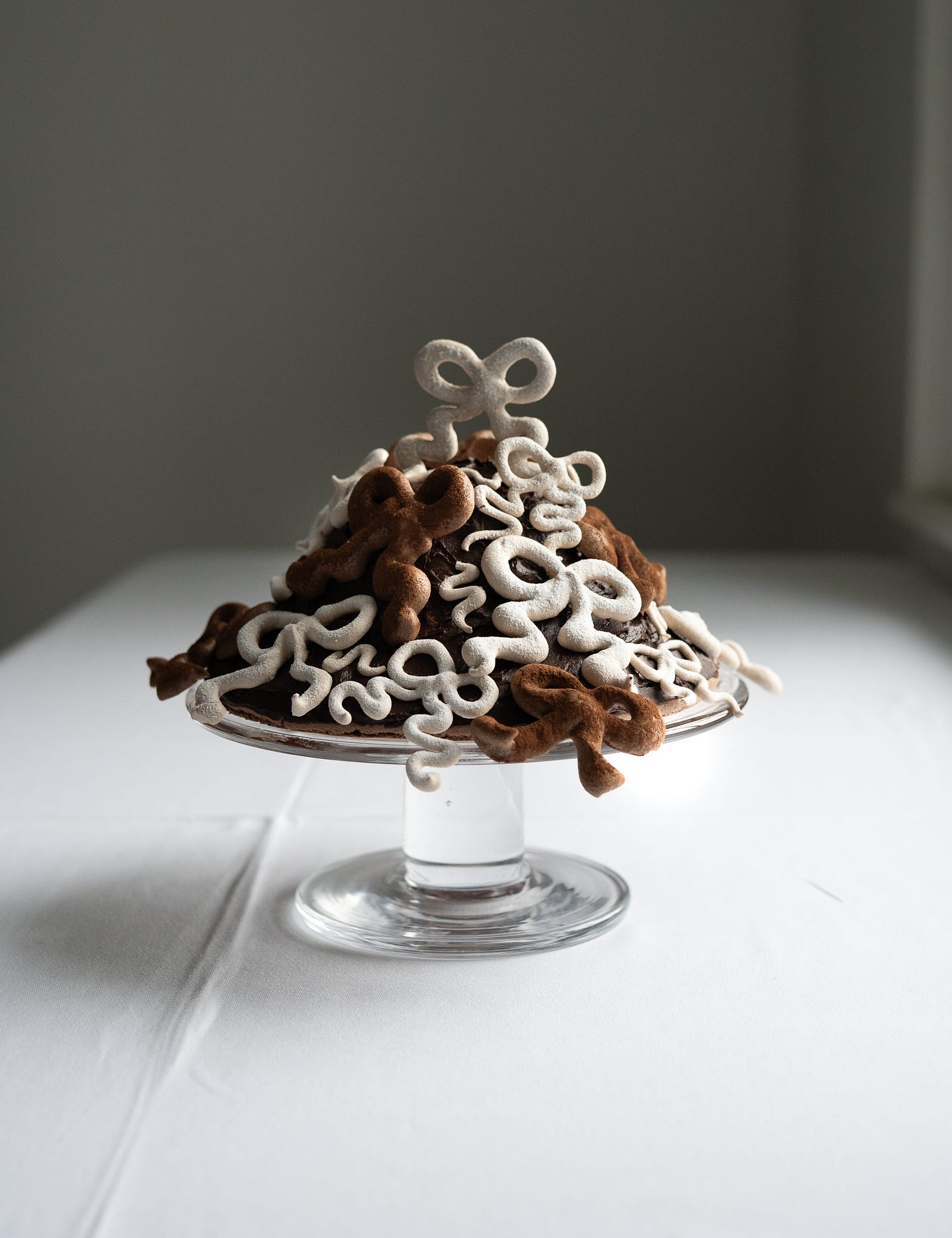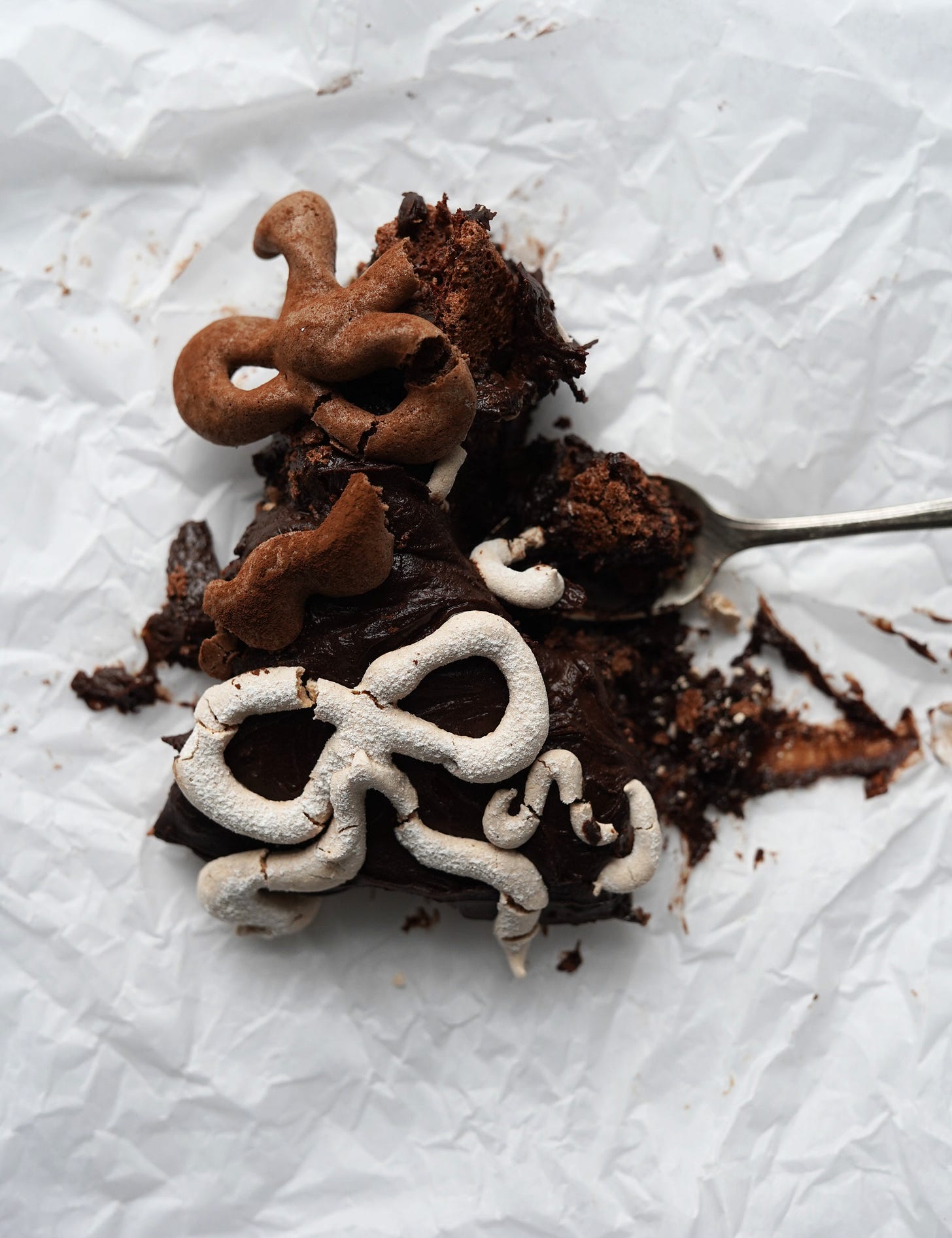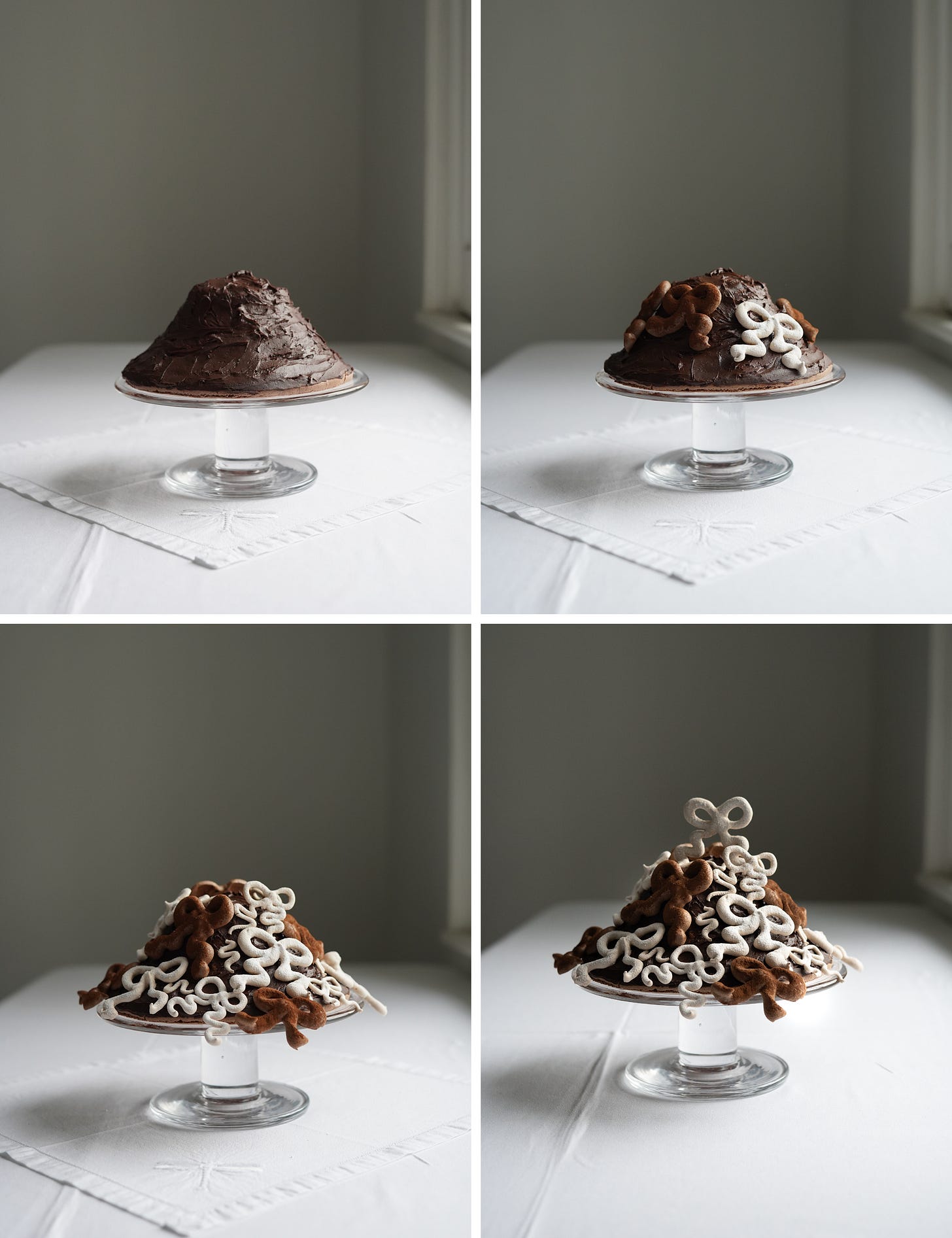Welcome back to The Christmas Menu #2. Last week, we began with the debut of my inaugural cookie box—if you missed it, the recipes are here. This week, I bring you two offerings: a main course and a legendary dessert, both of which I hope you’ll consider worthy of your Christmas Day table, but first, a story.
This is a rather long post, so if your email cuts out, you can view it in full on the website or app—or perhaps print it out and enjoy it like a food supplement from the weekend paper.
Frost laces the city in silver, biting and unrelenting—it permeates bone and marrow. Rainy puddles gleam, glass-like, each turned into icy crystal-coated mirrors. It’s December in Paris, and the streets shimmer, heavy with the crystalline stillness of winter.
Outside the bistros, red heat lamps flood the sidewalks with a soft, crimson glow. Parisians sit huddled beneath thick blankets, their shoulders draped in pashminas, gloved hands cradling steaming cups of espresso or chocolat chaud. Others, seemingly impervious to the cold, take long, deliberate drags on cigarettes, their eyes half-closed, a glass of red wine balanced effortlessly in hand. It seems the chill is no match for a good Burgundy and a strong hit of nicotine.
I see a couple at the far end of a shared, candlelit table as they lean over a cast-iron skillet brimming with bubbling cassoulet. Steam rises and drifts across the paper cloth marked by crimson rings. A second bottle is nearly empty, their laughter rises softly against the muffled quiet of the early evening.
It’s not yet 5 p.m., but the winter darkness has already cloaked the city, making every festooned window the stage setting for the lives within. Lights twinkle on garlands, their reflections dancing on cobblestones. Every corner of Paris seems to be a perfect vignette of a black and white 1950’s Christmas film.
I’m 12, and this is my first trip to France. I am instantly, hopelessly in love—a love affair, it turns out, that would last a lifetime. We pass by a pâtisserie, its name—Lenôtre—written in elegant gold script above windows jam-packed with treasures such as: delicate towers of macarons in jewel tones, pâte de fruits, and intricate festive chocolate sculptures.
Trays of hors d’oeuvres tempt wealthy, fabulously chic Parisian hosts, perfect for their glamorous cocktail soirées: lobster rolls, caviar-topped mini sandwiches, and smoked salmon elegantly draped over tiny blinis, each crowned with a delicate touch of gold leaf. And then there are the pastries—croissants, pain au chocolats, their golden pastry layers wrapped around dark chocolate; lemon-scented madeleines so delicate they seem to float. A mirrored dark chocolate cake takes center stage, its surface gleaming, adorned with double-chocolate leaves sculpted like fallen autumn foliage. Nearby, fresh cream confections are crowned with glistening raspberries, dusted with sugar as if kissed by frost.
To be a good cook, you must first be a good eater. By ‘good’, I mean having a ravenous enthusiasm, an unrelenting curiosity—greed, some might call it—for discovery and pleasure. An insatiable appetite not only for food, but also for life.
Growing up surrounded by the kind of home-cooked food that ruins you for life, I was blissfully unaware of how spoiled I was—my mother, an instinctive cook with the rare gift of combining a baker’s precision with a magician’s resourcefulness, could conjure meals out of whatever was at hand and make them taste incredible. I once visited a school friend’s house for supper and by 7pm there was no sustenance in sight. Wilting, I hungrily observed my friend’s father slumped in an armchair eating Cheerios from a mixing bowl with a large wooden spoon. No pots boiling on the stove, no delicious aromas seeping from the oven, rather a takeout menu and phone languishing on the counter. It was then that I realized how much home comfort I had taken for granted.
Certainly no cheerios in Paris….back to the story. After a long day of exploring the city—20,000 steps logged and every one of them worthwhile — Mum decided to stay behind and rest, leaving my father and me to brave the freezing evening air in search of dinner. For guidance, we turned to the hotel concierge—a stout, perpetually grouchy man who, to my young eyes, seemed ancient enough to have witnessed the French Revolution firsthand. With his broken English and our hopelessly mangled French (our translator, conveniently, was now fast asleep upstairs), he pointed outside "Local - very good!" he barked, his certainty brooking no argument.
Armed with an address scribbled in blue biro on the back of the hotel’s business card, we set off. True to his word, we soon found ourselves standing before a mysterious red door complete with a menu perched on a pedestal. Uncertain, I turned to my father."Dad, are you sure this is it?","Only one way to find out," he cheerfully replied, giving the door a push.
Dim light barely illuminated a narrow wooden staircase leading downward, and as we descended, it was as though we were entering a secret realm. The basement was vast—massive, even—filled with dozens of small, dark wooden tables draped in crisp white paper tablecloths. The air was thick with the smell of musk and Marlboros, freshly baked bread, and wine.
Waiters dressed in starched white shirts, black waistcoats, and matching bow ties glided through the space, balancing round trays with effortless grace. They scribbled orders directly onto the paper tablecloths, tallying everything at the end of the meal. Strangers shared tables, their voices mingling with the clatter of cutlery and the occasional pop of a cork.
It was smokey, chaotic, and ridiculously loud. A world within a world. I loved it.
Eventually, a waiter arrived at our table, radiating a sort of exasperated authority. I had a question: “What sort of chicken is on the special menu?” He scoffed, rolling his eyes as though the answer were obvious. “It is chicken chicken,” he said with a dramatic shrug. I ordered the duck.
Dad and I exchanged a glance, suppressing our laughter. At the next table, the woman waved our waiter over: “This dessert just doesn’t taste right,” she declared, her voice sharp with indignation. The waiter, visibly unamused, marched over, grabbed her plate, and, without hesitation, picked up a spoon and tasted it right there, in front of everyone, then slammed the plate back down on the table. “Non! Très bon. Nothing wrong with it,” he barked, turning on his heel and moving on to the next victims customers.
Experiences like this are forever etched into my memory, and today’s menu is inspired by those early Parisian adventures.
A main course and a dessert. First, duck à l’orange, reimagined. The addition of kumquats lends a sharper, more nuanced sweetness, balancing their vibrant bitterness against the richness of the duck. Paired with homemade black pepper frites, It’s a dish that feels at once familiar yet entirely new.
And for dessert, the Concorde: a layered, dream-like creation of crunchy chocolate meringue and silken chocolate mousse. This cake, originally created in 1969 by the legendary French chef Gaston Lenôtre, is a masterclass in contrasts—airy yet decadent, crisp yet meltingly smooth. It’s the kind of dessert that commands the table, equal parts elegance and indulgence, and an unforgettable finale to your Christmas feast.
Keep reading with a 7-day free trial
Subscribe to A Good Table to keep reading this post and get 7 days of free access to the full post archives.











